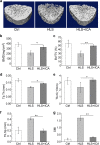Icariin prevents bone loss by inhibiting bone resorption and stabilizing bone biological apatite in a hindlimb suspension rodent model
- PMID: 29891857
- PMCID: PMC6289356
- DOI: 10.1038/s41401-018-0040-8
Icariin prevents bone loss by inhibiting bone resorption and stabilizing bone biological apatite in a hindlimb suspension rodent model
Abstract
Bone loss induced by microgravity is a substantial barrier to humans in long-term spaceflight. Recent studies have revealed that icariin (ICA) can attenuate osteoporosis in postmenopausal women and ovariectomized rats. However, whether ICA can protect against microgravity-induced bone loss remains unknown. In this study, the effects of ICA on a hindlimb suspension rodent model were investigated. Two-month-old female Wistar rats were hindlimb suspended and treated with ICA (25 mg·kg-1·d-1, i.g.) or a vehicle for 4 weeks (n = 6). The bone mass density of the hindlimbs was analyzed using dual-energy X-ray absorptiometry and micro-CT. mRNA expression of osteogenic genes in the tibia and the content of bone metabolism markers in serum were measured using qRT-PCR and ELISA, respectively. The bone mineral phase was analyzed using X-ray diffraction and atomic spectrometry. The results showed that ICA treatment significantly rescued the hindlimb suspension-induced reduction in bone mineral density, trabecular number and thickness, as well as the increases in trabecular separation and the structure model index. In addition, ICA treatment recovered the decreased bone-related gene expression, including alkaline phosphatase (ALP), bone glaprotein (BGP), and osteoprotegerin/receptor activator of the NF-κB ligand ratio (OPG/RANKL), in the tibia and the decreased bone resorption marker TRACP-5b levels in serum caused by simulated microgravity. Notably, ICA treatment restored the instability of bone biological apatite and the metabolic disorder of bone mineral elicited by simulated microgravity. These results demonstrate that ICA treatment plays osteoprotective roles in bone loss induced by simulated microgravity by inhibiting bone resorption and stabilizing bone biological apatite.
Keywords: apatite; bone loss; bone resorption; hindlimb suspension; icariin; simulated microgravity.
Conflict of interest statement
The authors declare no competing interests.
Figures







Similar articles
-
[Comparison research with icariin and genistein by anti-inflammatory reaction and angiogenesis pathway to inhibit bone loss on ovariectomized rats].Zhong Yao Cai. 2014 Apr;37(4):627-31. Zhong Yao Cai. 2014. PMID: 25345138 Chinese.
-
Comparison of the effects of genistein and zoledronic acid on the bone loss in OPG-deficient mice.Bone. 2008 May;42(5):950-9. doi: 10.1016/j.bone.2008.01.010. Epub 2008 Feb 8. Bone. 2008. PMID: 18337202
-
Salidroside Improves Bone Histomorphology and Prevents Bone Loss in Ovariectomized Diabetic Rats by Upregulating the OPG/RANKL Ratio.Molecules. 2018 Sep 19;23(9):2398. doi: 10.3390/molecules23092398. Molecules. 2018. PMID: 30235836 Free PMC article.
-
The effect of icariin on bone metabolism and its potential clinical application.Osteoporos Int. 2018 Mar;29(3):535-544. doi: 10.1007/s00198-017-4255-1. Epub 2017 Nov 6. Osteoporos Int. 2018. PMID: 29110063 Review.
-
High-Resolution X-Ray Tomography: A 3D Exploration Into the Skeletal Architecture in Mouse Models Submitted to Microgravity Constraints.Front Physiol. 2018 Mar 6;9:181. doi: 10.3389/fphys.2018.00181. eCollection 2018. Front Physiol. 2018. PMID: 29593553 Free PMC article. Review.
Cited by
-
Icariin Prevents Diabetes-Induced Bone Loss in Rats by Reducing Blood Glucose and Suppressing Bone Turnover.Molecules. 2019 May 15;24(10):1871. doi: 10.3390/molecules24101871. Molecules. 2019. PMID: 31096652 Free PMC article.
-
Wound Healing Effects of Dracontomelon dao on Bacterial Infection Wounds in Rats and Its Potential Mechanisms under Simulated Space Environment.Evid Based Complement Alternat Med. 2022 Jun 24;2022:4593201. doi: 10.1155/2022/4593201. eCollection 2022. Evid Based Complement Alternat Med. 2022. PMID: 35783508 Free PMC article.
-
Pharmacological inhibition of endoplasmic reticulum stress mitigates osteoporosis in a mouse model of hindlimb suspension.Sci Rep. 2024 Feb 27;14(1):4719. doi: 10.1038/s41598-024-54944-7. Sci Rep. 2024. PMID: 38413677 Free PMC article.
-
Electrospun Icariin-Loaded Core-Shell Collagen, Polycaprolactone, Hydroxyapatite Composite Scaffolds for the Repair of Rabbit Tibia Bone Defects.Int J Nanomedicine. 2020 May 1;15:3039-3056. doi: 10.2147/IJN.S238800. eCollection 2020. Int J Nanomedicine. 2020. PMID: 32431500 Free PMC article.
-
Effects of Icariin on Modulating Gut Microbiota and Regulating Metabolite Alterations to Prevent Bone Loss in Ovariectomized Rat Model.Front Endocrinol (Lausanne). 2022 Mar 24;13:874849. doi: 10.3389/fendo.2022.874849. eCollection 2022. Front Endocrinol (Lausanne). 2022. PMID: 35399950 Free PMC article.
References
-
- Ya-Jing Y, Da-Chuan Y, Peng S. Effect of microgravity and a high magnetic field on hydroxyapatite deposition and implications for bone loss in space. Appl Surf Sci. 2010;256:7535–9. doi: 10.1016/j.apsusc.2010.06.001. - DOI
-
- Schwarzenberg M, Pippia P, Meloni MA, Cossu G, Cogoli-Greuter M, Cogoli A. Microgravity simulations with human lymphocytes in the free fall machine and in the random positioning machine. J Gravit Physiol. 1998;5:P23–6. - PubMed
MeSH terms
Substances
LinkOut - more resources
Full Text Sources
Other Literature Sources
Miscellaneous

